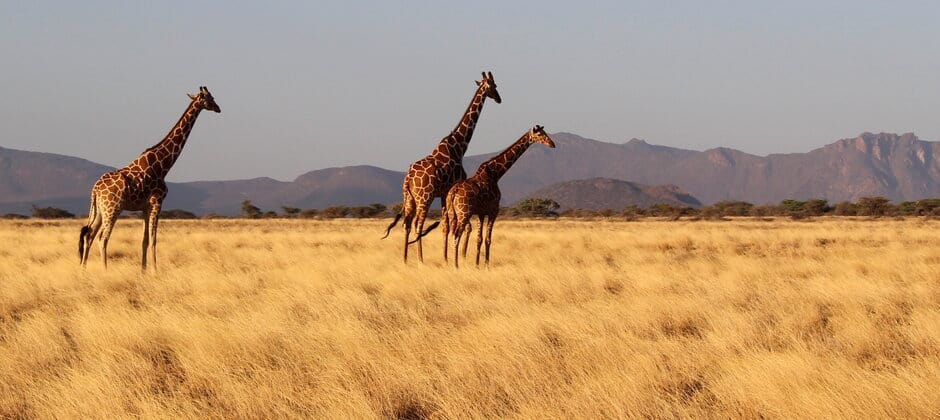Share this article
Animals share water—and parasites
When Georgia Titcomb was embarking on her PhD research in Kenya, she noticed a wide array of animals—both domestic and wild—eating, drinking and pooping all in the same place. They may be sharing more than resources, she realized. “Maybe,” she though, “these areas are really important for parasite transmission.”
She began taking fecal samples and looking at parasite eggs under a microscope, but she quickly learned that parsing parasite species was nothing short of impossible. Other options, like culturing larvae in the field or performing necropsies on dead animals to study their parasites, seemed like they would be impractical, inaccurate or both.
“I was skeptical that there was a viable way of going about it,” said Titcomb, now a postdoctoral researcher at the University of California Santa Barbara and an incoming faculty member at Colorado State University. “I was kind of thinking, how can I possibly figure out the answer to the simple question: Who shares parasites with whom?”
Soon she came across something in the literature that would change her direction. Scientists were using a genetic analysis of fecal samples known as dietary metabarcoding to determine what large herbivores were eating. At the time Ticomb was working at the Mpala Research Centre, in Laikipia County, Kenya, those researchers were also in Kenya. “I had observed them collect these samples in the very same place where I was working,” she said.
That inspired her. Coud metabarcoding also be used to detect parasite species in different hosts? She reached out to the researchers, including Rob Pringle and Tyler Kartzinel, and they shared their samples, helped her with work and became co-authors.
Titcomb wondered if there were predictable patterns in parasite sharing, and whether some species were more likely to have lots of parasites, while others had few. This could be important for predicting parasite diversity given the diversity of hosts.
Titcomb led a study published in Proceedings of the Royal Society B Biological Sciences to answer some of these questions using DNA metabarcoding. After her team’s analysis, some trends stood out.
Species in the same families, like zebras and donkeys, had more parasite sharing. Bovids, like cows and African buffalo (Syncerus caffer), also had a lot of parasite sharing and their own cluster of parasites.
Giraffes (Giraffa reticulate), though, foraging in treetops away from other species, were less likely to be infected by nematode parasites. But when they were infected, it was with a parasite also found in another host species. “They don’t really have that many exposure routes compared to other animals,” Titcomb said. She suspects that they might be exposed tor parasites via drinking from water sources. “Water seems to be the most likely source of fecal-oral transmission that can expose them to these parasites,” she said. “That was really fascinating to me.”
Other species also had unique differences. Elephants had a lot of parasitic nematode infections, but they were unlikely to share these worms with other species. Camels also had lots of nematode parasites, and they were sharing them with lots of other species.
These findings are important, Titcomb said because, under recent climate change, Kenya is experiencing much more drought, leaving cattle to compete with native ungulates for grass and forcing many herders to shift their livestock to camels. Camels are much more drought tolerant and can also eat vegetation that requires less water. If there is a high density of camels that overlap with wildlife, then they could have direct effects on parasite composition in the area.
Titcomb said in addition to learning about conservation and ecology, learning more about parasites can enlighten researchers to other fecal-oral transmitted diseases that wildlife share with livestock that could potentially affect humans. Invasive species, she added, can also bring in new parasites and change parasite compositions in ecosystems.
Titcomb said there’s still a lot of work to do on parasites. The study brings up new questions like if there are parasite superspreaders, and if water sources are, in fact, important areas for transmission. In addition, she knows that parasites have a complicated range of effects on hosts. Some don’t hurt species at all. Others can be lethal. For example, she said, a parasite that’s highly pathogenic to sheep could be much less so for antelope. That can be an additional area of study.
Overall, the study shows the use of a “fantastic new tool to really study the ecology of parasites in the Anthropocene,” she said. “We can take these samples without bothering the animals, and we can now study their parasites over time and space. I think that’s going to be really valuable as we continue to look at what happens under different types of changes and different scenarios.”
Header Image: Fewer than half of reticulated giraffes had a nematode infection but were highly likely to share those parasites with other species. Credit: HandsLive








